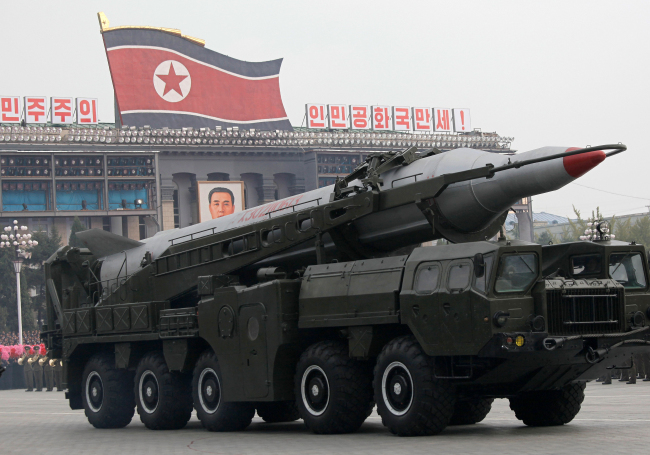U.S. warns of N. Korean nuke, missile capabilities
By Korea HeraldPublished : April 8, 2015 - 20:12
Senior U.S. officials have highlighted North Korea’s evolving nuclear and missile capabilities this week in an apparent push for reinforcement of America’s missile defense program.
Their remarks came amid raging controversy here over the U.S.’ potential deployment of the Terminal High-Altitude Area Defense system, a core element of its multilayered missile defense program, to Korea.
U.S. Northern Command head Adm. William Gortney said Tuesday that Pyongyang was thought to be capable of miniaturizing a nuclear warhead to mount on a long-range missile. It was the first time that a top U.S. officer has confirmed that the North had secured miniaturization technology.
“Our assessment is that they have the ability to put it on ― a nuclear weapon on a KN-08 and shoot it at the (U.S.) homeland,” Gortney said during a press briefing at the Pentagon, referring to the North’s intercontinental ballistic missile with a range of up to 12,000 km.
Their remarks came amid raging controversy here over the U.S.’ potential deployment of the Terminal High-Altitude Area Defense system, a core element of its multilayered missile defense program, to Korea.
U.S. Northern Command head Adm. William Gortney said Tuesday that Pyongyang was thought to be capable of miniaturizing a nuclear warhead to mount on a long-range missile. It was the first time that a top U.S. officer has confirmed that the North had secured miniaturization technology.
“Our assessment is that they have the ability to put it on ― a nuclear weapon on a KN-08 and shoot it at the (U.S.) homeland,” Gortney said during a press briefing at the Pentagon, referring to the North’s intercontinental ballistic missile with a range of up to 12,000 km.

“We assess that it’s operational today, and so we practice to go against it. … We haven’t seen them test the KN-08 yet and we’re waiting to do that.”
Noting the unpredictable nature of the communist regime, Gortney also said that the road-mobile launcher of the KN-08 is a source of concern. “We’re very concerned about the mobile nature of the KN-08. We lose our ability to get the indication that something might occur,” he said.
Seoul’s Defense Ministry said U.S. intelligence authorities have confirmed that what Gortney said does not represent the official stance of the U.S. government.
The KN-08 missile was unveiled on April 15, 2012, during a military parade to mark the Day of the Sun, the birthday of the North’s national founder Kim Il-sung. As it had not been seen being tested, some argued that the missile could be a mock-up.
According to the latest analysis by the U.S.-Korea Institute at the Johns Hopkins School of Advanced International Studies, the KN-08 ICBM would reach an initial operational capability with growing numbers deployed by 2020.
Meanwhile, Frank Rose, U.S. assistant secretary of state for arms control, verification and compliance, said THAAD was a “critical capability” in defending against North Korea’s Rodong and Scud ballistic missiles.
“U.S. missile defenses in the Asia-Pacific region are designed to deal with the threat from North Korea, specifically their threat from Rodongs as well as extended-range Scuds,” Rose told reporters following a seminar at the Center for Strategic and International Studies.
“So the bottom line is: no decision to date. Nor are there any negotiations underway between the U.S. and the ROK (South Korea) on this issue. But what I would say is that in the future, were we to move in this direction, THAAD would be a critical capability to dealing with the threats from North Korea’s Rodong and extended-range Scuds.”
The North has deployed some 1,000 missiles that can strike the South, a reason why calls are mounting for a stronger missile defense against those missiles ― some 700 Scud-B and -C missiles with ranges of 300-500 km and about 300 Rodong missiles with a range of around 1,300 km.
The potential deployment of THAAD has been a hot-button issue here as China has repeatedly expressed opposition to it, fearing that the system would undermine the regional security balance, escalate military tension and potentially spark an arms race.
The issue is expected to be unofficially discussed during the talks between Seoul’s Defense Minister Han Min-koo and his U.S. counterpart Ashton Carter on Friday. Carter is to arrive here Thursday for a three-day visit for talks with senior officials and U.S. troops here.
Apparently mindful of the opposition from Beijing, Seoul said that THAAD would not be on the official agenda for the talks between Han and Carter. But the two are to discuss ways to better counter the North’s nuclear and missile threats which are high on the agenda.
By Song Sang-ho (sshluck@heraldcorp.com)
-
Articles by Korea Herald





![[Herald Interview] 'Amid aging population, Korea to invite more young professionals from overseas'](http://res.heraldm.com/phpwas/restmb_idxmake.php?idx=644&simg=/content/image/2024/04/24/20240424050844_0.jpg&u=20240424200058)












![[KH Explains] Korean shipbuilding stocks rally: Real growth or bubble?](http://res.heraldm.com/phpwas/restmb_idxmake.php?idx=652&simg=/content/image/2024/04/25/20240425050656_0.jpg&u=)

